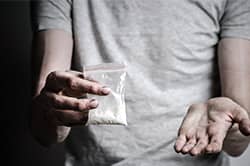Cocaine Detox Centers
 Cocaine is a powerful stimulant drug that is very addictive. People who abuse it often have extreme difficulty quitting and will likely experience withdrawal symptoms.
Cocaine is a powerful stimulant drug that is very addictive. People who abuse it often have extreme difficulty quitting and will likely experience withdrawal symptoms.
Cocaine withdrawal typically causes more mental than physical problems. In addition to cravings, people may experience depression, which can contribute to an increased risk of suicide or relapse.1
Centers for cocaine detox offer some of the best ways to manage withdrawal symptoms. Many users can be treated on an outpatient basis. But inpatient facilities offer a higher level of support and care to help those in recovery establish and maintain a clean and sober lifestyle.
After detox, people in recovery are encouraged to engage in some form of rehab or a 12-step program to learn how to avoid and deal with triggers and prevent relapse. One study found that relapse rates were 23.5% for cocaine users in the year following treatment, and those who remained in treatment for 90 days or longer had better outcomes.3
Signs and Symptoms of Withdrawal
The cocaine withdrawal symptoms that one will experience depend on a wide range of factors, such as length of use, amount used, physical health status, and most common method of use (e.g., snorting, smoking, injecting).
Some of the more common detox symptoms people experience include:4
- Depression.
- Sleep disturbances.
- Fatigue.
- Anxiety.
- Irritability.
- Poor concentration.
- Slowed physical activity, such as movements or speech.
- Increased appetite.
- Paranoia.
- Cravings.
Strong cravings are one of the main features of cocaine withdrawal. In many cases, cravings can last for months and contribute to relapse.1 Cravings can persist even after people have received treatment, which is why it is important to stay involved in some form of aftercare, such as 12-step meetings, sober living, or therapy.
Duration
The cocaine detox timeline can vary from person to person. Generally speaking, the timeline consists of three distinct phases, including:5
- Phase one. Often referred to as the “crash,” this phase occurs within a few hours to a few days of last use. Symptoms can include exhaustion, increased desire to sleep, decreased mood, increased appetite, restlessness, and irritability.
- Phase two. Also known as the “withdrawal” stage, this phase occurs 1–10 weeks after last use. Symptoms include lethargy, anxiety, erratic sleep patterns, strong cocaine cravings, irritability, depression, reduced concentration, and mood swings.
- Phase three. Known as the “extinction” phase, this stage can last for up to 28 weeks. People may experience periodic cravings and suffer from feelings of unease or dissatisfaction with life.
Do You Need a Detox Program?
 Some people try to detox from cocaine at home or with kits. However, this could be dangerous in some cases, since cocaine withdrawal is associated with an increased risk of complications such as depression, relapse and subsequent overdose, and suicide. People detoxing at home do not have access to medical services that might address these developments.1 Health care professionals can supervise withdrawal and provide assistance for depression or other mental health issues, such as agitation, or physical health concerns, such as heart problems or seizures.1, 4
Some people try to detox from cocaine at home or with kits. However, this could be dangerous in some cases, since cocaine withdrawal is associated with an increased risk of complications such as depression, relapse and subsequent overdose, and suicide. People detoxing at home do not have access to medical services that might address these developments.1 Health care professionals can supervise withdrawal and provide assistance for depression or other mental health issues, such as agitation, or physical health concerns, such as heart problems or seizures.1, 4
Other benefits of professional detox facilities for cocaine include programs to help people identify and work through the social, emotional, and relationship issues that may have led to their addiction. Some even offer help with housing or employment.
Outpatient
Many people who want to overcome cocaine addiction can be treated on an outpatient basis. Specifically, intensive outpatient programs and partial hospitalization programs are often useful for people who are struggling with mild to moderate cocaine detox symptoms.4
During outpatient detox, people live at home. But in most cases, they travel on a regular schedule to a facility to receive support, medications as needed, and monitoring. Some detox programs – mainly those offered by home health care agencies – may provide care in a patient’s home.4
Outpatient programs are offered in a range of settings, including physicians’ offices, outpatient detox centers, and day treatment centers in hospitals.4
Inpatient
People who have a higher risk of relapse or who suffer from psychiatric issues, seizures, or other mental or physical health concerns are encouraged to seek treatment at an inpatient cocaine detox facility. People who have been heavy or long-term cocaine users or who have a prior history of relapse may also benefit from inpatient treatment.
Inpatient treatment provides 24/7 medical and psychiatric care and monitoring in a trigger-free environment. Medically supervised inpatient programs can also offer specific medications to treat depression, other psychiatric conditions, or physical health symptoms. The Food and Drug Administration has not approved any medications to specifically treat cocaine withdrawal, although many are undergoing testing.1,4,6
Since suicide is a potential risk during withdrawal, the medical monitoring available at inpatient programs or professional cocaine detox centers can help people stay safe and avoid self-harm.4
Recovering From Addiction
 After completing detox, enrolling in a rehab program, 12-step program, or another form of addiction recovery therapy can ensure your best chances of staying clean and sober.
After completing detox, enrolling in a rehab program, 12-step program, or another form of addiction recovery therapy can ensure your best chances of staying clean and sober.
Many people use cocaine as a way to manage stress, mental illness, or other life problems. After they quit using, they need to learn drug-free ways of coping with these problems. The National Institute on Drug Abuse reports that behavioral therapy, such as that offered in both inpatient and outpatient programs, is one of the most effective forms of treatment for cocaine addiction.6 Two behavioral therapies that can reduce the potential for relapse are:
- Cognitive behavioral therapy (CBT). This form of therapy helps people identify and change negative thought patterns that contribute to drug use. People learn to recognize and avoid their triggers and cope with the life problems and concerns that have been factors in their drug use.6
- The Matrix Model. People in recovery learn about addiction and relapse, receive reinforcement for positive behaviors, and receive education about self-help programs. They may participate in a wide range of treatments, such as family therapy, relapse prevention education classes, group therapy, drug education, and self-help groups. Many studies show that people who participate in the Matrix Model have significant reductions in drug use and demonstrate improved well-being.7
Sources
- U.S. National Library of Medicine. (2015). Cocaine withdrawal.
- National Institute on Drug Abuse. (2016). What are the long-term effects of cocaine use?
- Simpson, D. Joe, G., and Fletcher, B. (1999). A national evaluation of treatment outcomes for cocaine dependence. Archives of General Psychiatry, 56 (6), 507–514.
- Substance Abuse and Mental Health Services Administration. (2006). Detoxification and substance abuse treatment: Treatment Improvement Protocol (TIP) Series, No. 45.Rockville, MD: Substance Abuse and Mental Health Services Administration.
- Australian Government Department of Health. (2004). The cocaine withdrawal syndrome.
- National Institute on Drug Abuse. (2016). How is cocaine addiction treated?
- National Institute on Drug Abuse. (2012). The matrix model (stimulants).
